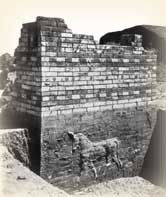
Throughout 1898 and the early part of 1899 Robert Koldewey reconnoitered the ancient city of Babylon. A brilliant architect and archaeologist, he knew he was to be appointed to head the digging. The German Oriental Society was picking up the tab and outfitting the expedition in full. The real work began after he received the expected authorization. On this date, March 23, 1899, he began excavation in earnest on the east side of the mound of Kasr.
Digging with 200 workers, Koldewey soon was writing excitedly of great finds. A relief he estimated at 960 feet long came to light. He uncovered the enormous walls of Babylon, so wide four span of horses could drive abreast. Babylon had been enormous, larger than any other citadel known to history. Not only this, but it was built of fired brick, not crumbly sun-baked clay. The bricks were stamped with Nebuchadnezzar's name.
Koldewey unearthed the base of a tower on which King Nabopolassar claimed "At that time Marduk [the god] commanded me to build the Tower of Babel which had become weakened by time and fallen into disrepair..." Wherever Koldewey turned his spade, he turned up verification of things the Bible had to say about the great kings and empires that once existed in the Mideast.
Josephus, too, was verified. He had mentioned the hanging gardens of Babylon. The stone arches that supported these were also unearthed by the hardworking German.
The archaeological team shipped the Gate of Ishtar from Processional way of Marduk to Germany and reassembled it to be marveled at by visitors. This was from Babylon's defensive entrance street. On either side of this sunken road, walls rose up forty feet and were lined by 120 stone reliefs with bas reliefs of yellow lions against blue tile. Koldeway shipped many other objects to Germany, among them a basket full of 300 cuneiform tablets.
These were administrative tablets taken from an outbuilding some distance from the Ishtar gate. Nothing much of interest there, it seemed. Not until after 1933 did anyone trouble to fully decipher these bureaucratic texts. But then E. F. Weidener announced an electrifying record corroborating Scripture.
According to Scripture, King Jehoiachin of Judah had been taken into captivity around 600 B.C. Jeremiah says that after a period of suffering the Babylonian King lifted him up and "...Jehoiachin put aside his prison clothes and for the rest of his life ate regularly at the king's table. Day by day the king of Babylon gave Jehoiachin a regular allowance as long as he lived, till the day of his death." Here, on cuneiform was verification of the Biblical text, listing the supplies given king Jehoiachin of Judah. It was a welcome find as critics had long scoffed at the Bible as unhistorical. Koldewey had dug up more than Babylon. He had dug up priceless data that would help us better understand God's word.
Bibliography:
- Ceram, C. W. Gods, Graves and Scholars. New York: Bantam, 1962.
- Koldeway, Robert. Wieder erstehende Babylon. Leipzig: Hinrichs', 1913.